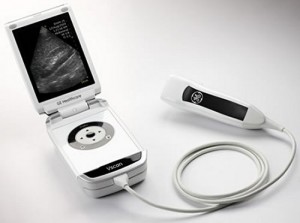 A new study published in the Archives of Internal Medicine found that pocket mobile echocardiography (PME) devices like GE's Vscan provide “accurate assessments” of ejection fraction, and some cardiac structures in many patients, according to a report in CMIO.
A new study published in the Archives of Internal Medicine found that pocket mobile echocardiography (PME) devices like GE's Vscan provide “accurate assessments” of ejection fraction, and some cardiac structures in many patients, according to a report in CMIO.
The study, funded by The National Institutes of Health, came about due to the recent release of Vscan, a cellphone-sized PME device from GE Healthcare designed for clinical use. Dr. Max J. Liebo and colleagues from the Scripps Clinic in La Jolla, Calif., wanted to compare quickly-acquired PME images with those acquired by standard TTE.
At the Consumer Electronic Show in 2010 Scripps Health's Dr Eric Topol, a cardiologist, demonstrated the GE Vscan to the public for the first time: “What a fantastic image — it’s comparable to any other ECHO machine. People are going to be doing their own ECHOs and sending them to their doctors in the not too distant future,” he predicted at the time.
Clinicians could visualize some but not all echocardiographic measurements with the devices: “Observer agreement was fair to moderate for some measurements among less-experienced readers,” the researchers reported.
Currently, there is no reimbursement category for performing or interpreting PME, and the Vscan device reportedly costs $7900. Researchers noted that PME testing is free and quick, while the fee for TTE hovers around $1,000 and takes about 40 minutes.
The study characterized the PME results “promising” but more studies with a larger number of patients with more varied cardiac abnormalities are still needed. The researchers also noted that studies should look into how untrained clinicians fare by obtaining and analyzing images with the devices.
At the Wireless Life Sciences Alliance event in May, Topol told attendees that devices like the Vscan improve the patient-physician relationship. In order to have imaging scans done today, most patients leave the physician to have the scan done, Topol explained. While that is being carried out the patient cannot discuss what the tech is seeing, but when a physician uses a pocket ultrasound device they can explain what they are seeing in real-time so the patient can see what’s going on too.
You can read the CMIO article here.

















